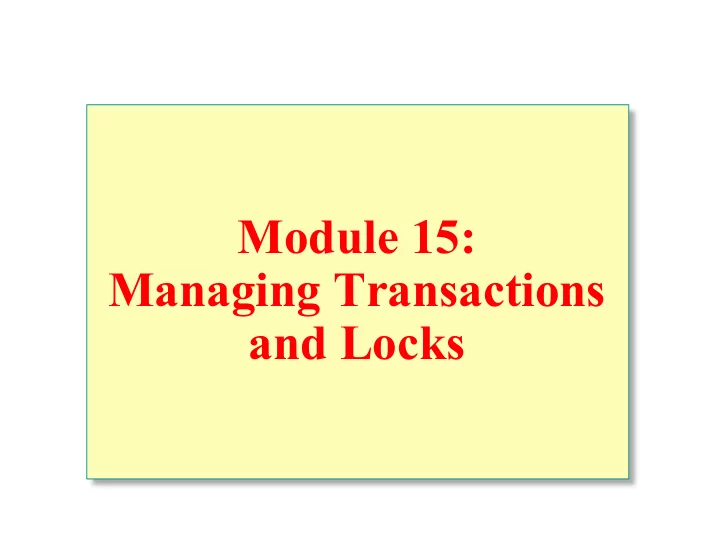

Module 15: Managing Transactions and Locks
Overview Introduction to Transactions and Locks Managing Transactions SQL Server Locking Managing Locks
Introduction to Transactions and Locks Transactions Ensure That Multiple Data Modifications Are Processed Together Locks Prevent Update Conflicts Transactions are serializable Locking is automatic Locks allow concurrent use of data Concurrency Control
Managing Transactions Multimedia Presentation: SQL Server Transactions Transaction Recovery and Checkpoints Considerations for Using Transactions Setting the Implicit Transactions Option Restrictions on User-defined Transactions
Multimedia Presentation: SQL Server Transactions
Transaction Recovery and Checkpoints Transaction Recovery Action Required 1 1 None 2 2 Roll forward 3 3 Roll back 4 4 Roll forward 5 5 Roll back Checkpoint System Failure
Transaction Recovery and Checkpoints Transaction Log ZOT! Recovery Needed? NONE Time (and place in log) INSERT … DELETE … UPDATE … … Recovery Needed? ROLL FORWARD Recovery Needed? ROLL BACK INSERT … DELETE … COMMIT UPDATE … … CHECKPOINT Recovery Needed? ROLL FORWARD INSERT … DELETE … UPDATE … Transaction Log … INSERT … Recovery Needed? ROLL BACK DELETE … COMMIT UPDATE … … INSERT … DELETE … Database UPDATE … … COMMIT CRASH!!!
Considerations for Using Transactions Transaction Guidelines Keep transactions as small as possible Use caution with certain Transact-SQL statements Avoid transactions that require user interaction Issues in Nesting Transactions Allowed, but not recommended Use @@trancount to determine nesting level
Setting the Implicit Transactions Option Automatically Starts a Transaction When You Execute Certain Statements Nested Transactions Are Not Allowed Transaction Must Be Explicitly Completed with COMMIT or ROLLBACK TRANSACTION By Default, Setting Is Off SET IMPLICIT_TRANSACTIONS ON
Restrictions on User-defined Transactions Certain Statements May Not Be Included in a Transaction ALTER DATABASE RECONFIGURE BACKUP LOG RESTORE DATABASE CREATE DATABASE RESTORE LOG DROP DATABASE UPDATE STATISTICS
SQL Server Locking Concurrency Problems Prevented by Locks Lockable Resources Types of Locks Lock Compatibility
Concurrency Problems Prevented by Locks Lost Update Uncommitted Dependency (Dirty Read) Inconsistent Analysis (Nonrepeatable Read) Phantoms Reads
Lockable Resources Item Description Item Description RID Row identifier Key Row lock within an index Page Data page or index page Extent Group of pages Table Entire table Database Entire database
Types of Locks Basic Locks Shared Exclusive Special Situation Locks Intent Update Schema Bulk update
Lock Compatibility Locks May or May Not Be Compatible with Other Locks Examples Shared locks are compatible with all locks except exclusive Exclusive locks are not compatible with any other locks Update locks are compatible only with shared locks
Managing Locks Session-Level Locking Options Dynamic Locking Architecture Table-Level Locking Options Deadlocks Displaying Locking Information
Session-Level Locking Options Transaction Isolation Level READ COMMITTED (DEFAULT) READ UNCOMMITTED REPEATABLE READ SERIALIZABLE Locking Timeout Limits time waiting for a locked resource Use SET LOCK_TIMEOUT
Dynamic Locking Architecture Dynamic Locking Cost Row Page Table Granularity Locking Cost Concurrency Cost
Table-Level Locking Options Use with Caution Can Specify One or More Locking Options for a Table Use optimizer_hints Portion of FROM Clause in SELECT or UPDATE Statement Overrides Session-Level Locking Options
Deadlocks How SQL Server Ends A Deadlock How to Minimize Deadlocks How to Customize the Lock Time-Out Setting
Displaying Locking Information Current Activity Window sp_lock System Stored Procedure SQL Profiler Windows 2000 System Monitor Additional Information
Recommended Practices Keep Transactions Short Design Transactions to Minimize Deadlocks Use SQL Server Defaults for Locking Be Careful When You Use Locking Options
Review Introduction to Transactions and Locks Managing Transactions SQL Server Locking Managing Locks
Recommend
More recommend